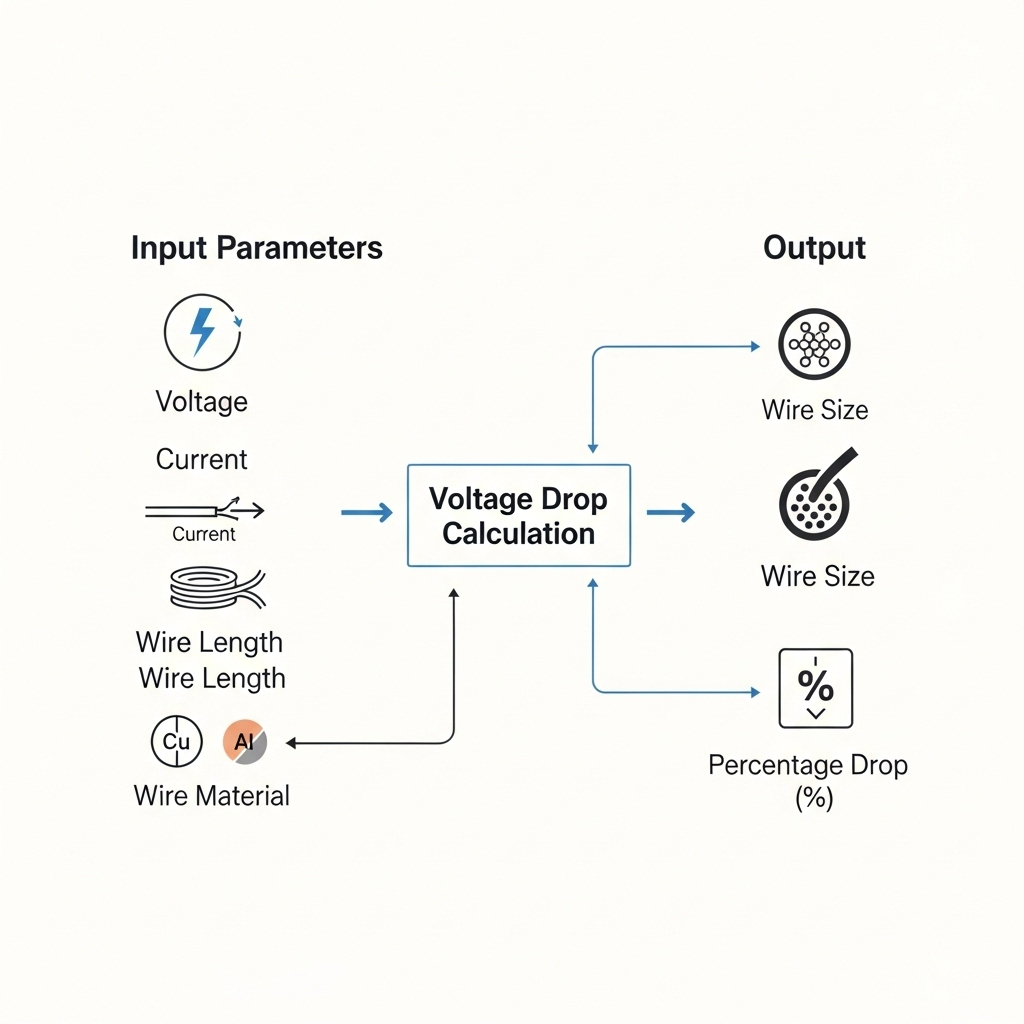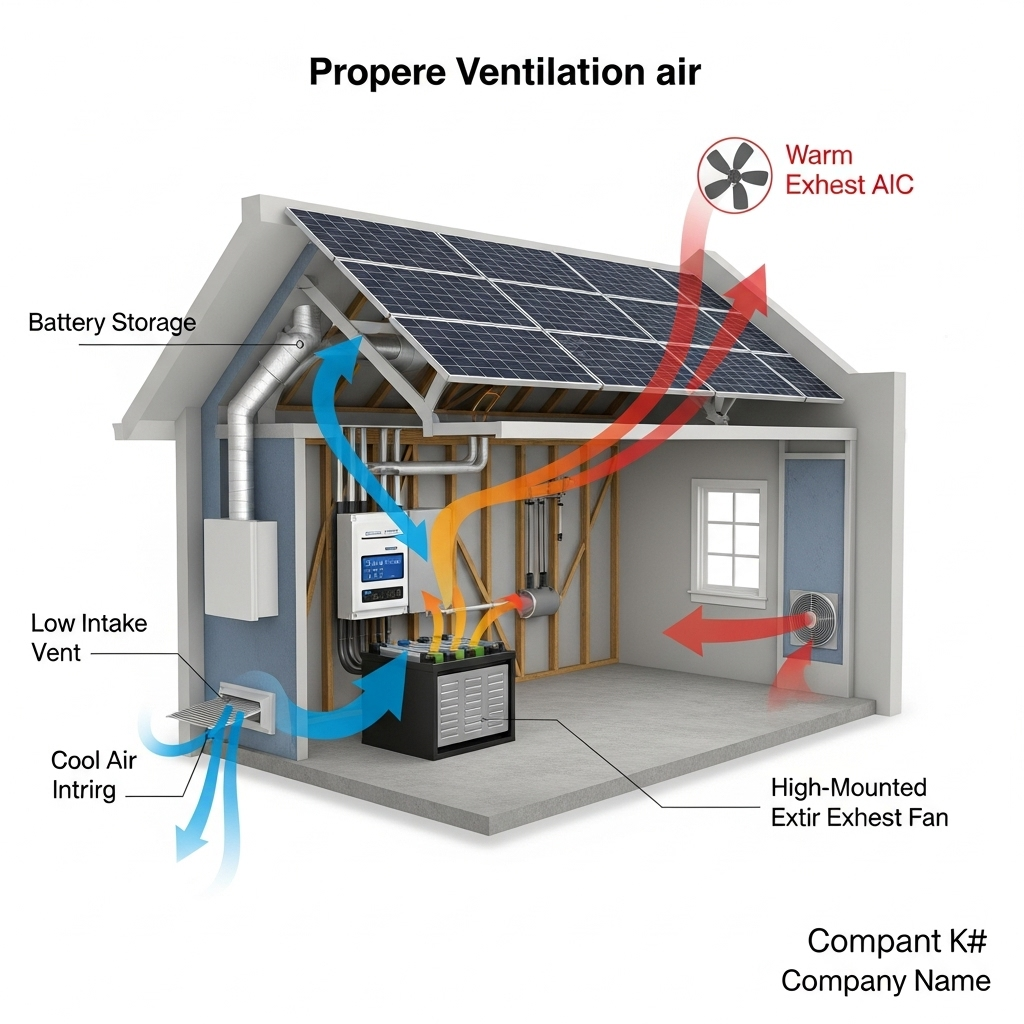A solar inverter that repeatedly shuts down for no apparent reason is a significant frustration. These 'nuisance trips' often point not to a faulty inverter, but to a foundational issue in system design: incorrectly sized conductors. Proper conductor sizing is essential for the stability and efficiency of any solar power system. When wires are too small for the job, they can trigger protective shutdowns, reduce energy harvest, and compromise the long-term health of your equipment.
The Critical Link Between Conductor Size and Inverter Stability
Understanding the relationship between your wiring and inverter performance is the first step toward building a reliable energy system. Inverters are sensitive devices that require stable voltage to operate correctly. Undersized conductors directly undermine this stability.
Understanding Voltage Drop
Voltage drop is the reduction in electrical potential along the path of a current-carrying wire. Think of it as a loss of pressure in a water hose; the longer the hose, the lower the pressure at the end. This phenomenon occurs because every conductor has some level of resistance. As current flows through this resistance, a portion of the voltage is lost, converting into heat. For solar inverters, which operate within a specific voltage window, even a small drop can be problematic. The National Electrical Code (NEC) generally recommends keeping voltage drop below 3% to ensure optimal performance.
How Inverters React to Poor Voltage
Inverters are designed with built-in safety features to protect themselves from damaging electrical conditions. If the voltage at the inverter's terminals falls below its minimum operational threshold due to excessive voltage drop, the inverter will register this as a fault condition and shut down. This is a 'nuisance trip' because the system itself is not faulty, but the wiring is inadequate to deliver the necessary voltage under load. These trips interrupt power production and can place unnecessary stress on the inverter's components over time.
Mistake 1: Ignoring the Impact of Conductor Length
One of the most frequent errors in conductor sizing is underestimating the effect of wire length. The principle is straightforward: resistance is directly proportional to the length of the conductor. The farther electricity has to travel, the more voltage is lost along the way.
The Longer the Wire, the Greater the Resistance
A long cable run, especially on the DC side of the system between the batteries and the inverter, can introduce significant resistance. This leads to a substantial voltage drop, particularly when the inverter is under a heavy load. For example, a wire size that is adequate for a 5-foot run may be completely insufficient for a 25-foot run, causing the inverter to trip when a large appliance starts up.
Practical Application: Planning Your System Layout
To mitigate this, design your system with the shortest possible cable runs between key components. Place your battery bank and inverter as close to each other as is safely possible. If a long wire run is unavoidable, you must compensate by increasing the conductor's size (using a thicker wire) to reduce its overall resistance.
Mistake 2: Overlooking Temperature Effects (Derating)
Ambient temperature plays a crucial role in a conductor's ability to carry current safely. As wires heat up, their electrical resistance increases, which in turn magnifies voltage drop and reduces their effective current-carrying capacity, or ampacity.
Heat Increases Resistance
Conductors installed in hot environments, such as attics, on sun-exposed rooftops, or bundled together in a conduit, will operate at higher temperatures. This increased heat must be accounted for in your calculations. The NEC provides specific temperature correction factors to 'derate' a wire's ampacity based on the expected ambient temperature.
Applying Temperature Correction Factors
Failing to apply these correction factors is a common mistake that leads to selecting a wire that is too small. For instance, a wire rated to carry 100 amps at 30°C (86°F) will have a significantly lower safe ampacity at 50°C (122°F). Using a derating table is a necessary step for a safe and reliable installation.
| Ambient Temperature (°C) | Correction Factor | Derated Ampacity of 100A Wire |
|---|---|---|
| 30°C | 1.00 | 100 A |
| 40°C | 0.91 | 91 A |
| 50°C | 0.82 | 82 A |
| 60°C | 0.71 | 71 A |
Mistake 3: Miscalculating Ampacity Requirements
Ampacity is the maximum current a conductor can handle continuously without exceeding its temperature rating. A common error is sizing conductors only for the inverter's continuous rating while ignoring its surge capacity and regulatory requirements.
Sizing for Continuous vs. Peak Loads
Many appliances, especially those with motors, require a large surge of current to start up. Your inverter is designed to handle these momentary peak loads. The conductors connecting the battery to the inverter must also be able to handle this surge without causing the voltage to plummet and trip the inverter.
The 125% Rule for Continuous Duty
For safety and performance, electrical codes typically require that conductors for continuous loads be sized to handle 125% of that load. This provides a buffer, ensuring the wires do not overheat during prolonged operation and can better manage voltage stability. Applying this rule is a critical step in preventing nuisance trips and ensuring a safe system.
Mistake 4: Using the Wrong Conductor Material
The two most common materials for electrical conductors are copper and aluminum. While both are effective, they have different properties that directly impact sizing calculations. Copper is a better conductor than aluminum, meaning it has lower resistance for the same physical size.
Copper vs. Aluminum
If you choose aluminum wire to save on costs, you must use a larger gauge wire to achieve the same ampacity and voltage drop performance as a smaller copper wire. An aluminum conductor generally needs to have a cross-sectional area about 50-60% larger than a copper conductor to carry the same current. Ignoring this difference will result in undersized wires, excessive voltage drop, and potential inverter tripping.
| Property | Copper | Aluminum |
|---|---|---|
| Relative Conductivity | 100% | ~61% |
| Tensile Strength | Higher | Lower |
| Corrosion Resistance | Higher | Lower (requires antioxidant compound) |
| Cost | Higher | Lower |
Mistake 5: Neglecting Terminal Temperature Ratings
A circuit is only as robust as its weakest point. In electrical systems, this often comes down to the connection points. Inverters, circuit breakers, and fuse holders all have terminals with a specific maximum temperature rating (e.g., 60°C, 75°C, or 90°C).
A Chain Is Only as Strong as Its Weakest Link
You might use a wire with high-temperature insulation rated for 90°C, but if the inverter terminals it connects to are only rated for 75°C, you must size the wire based on the 75°C ampacity rating. Overlooking this detail can cause the terminals to overheat, leading to a failed connection, equipment damage, or a potential fire hazard.
Mistake 6: Forgetting About AC and DC Side Differences
A solar energy system has both a DC (Direct Current) side and an AC (Alternating Current) side, and the rules for conductor sizing are different for each. The relationship between power, voltage, and current (Power = Voltage x Current) is key.
DC Circuits: Lower Voltage, Higher Current
The DC circuit, which connects the solar panels and battery to the inverter, typically operates at a lower voltage (e.g., 12V, 24V, or 48V). To deliver the same amount of power, a lower voltage requires a much higher current. This high current makes the DC side extremely sensitive to voltage drop. Even a small amount of resistance in the DC wiring can cause a significant voltage drop, making it the most common location for sizing errors that lead to inverter trips.
AC Circuits: Higher Voltage, Lower Current
On the AC side, from the inverter to your appliances, the voltage is higher (e.g., 120V or 240V). Consequently, the current is much lower for the same power output. While still important, voltage drop is generally less of a concern here unless the wire runs are exceptionally long.
Mistake 7: Relying Solely on Basic Wire Gauge Charts
Generic wire gauge charts found online can be a helpful starting point, but they are not a substitute for a thorough calculation. These charts often make simplifying assumptions and may not account for all the critical variables in your specific installation.
Charts Are a Starting Point, Not the Final Answer
A basic chart might not factor in ambient temperature, the number of conductors bundled in a conduit, or the precise length of your wire run. It also won't know the specific voltage drop percentage you are targeting for your system's efficiency. Relying on such a chart can easily lead to an undersized conductor.
The Importance of a Comprehensive Calculation
Always use a detailed voltage drop calculator that allows you to input all relevant variables: conductor material, length, current, voltage, and desired voltage drop percentage. This ensures an accurate result tailored to your system. For a deeper look into how these factors affect overall system efficiency, the relationship between voltage, current, and power is detailed in this reference on solar storage performance. Evolving grid codes also emphasize the need for robust system design, as detailed in publications like Grid Codes for Renewable Powered Systems by IRENA.
A Proactive Approach to System Reliability
Avoiding nuisance trips and ensuring your inverter performs optimally comes down to careful planning and attention to detail. Conductor sizing is not an area to cut corners. Investing in properly sized, high-quality conductors is a small price to pay for a system that is safe, efficient, and reliable for years to come. By avoiding these seven common mistakes, you build a resilient energy system that delivers power without interruption. As the IEA highlights in its report on System Integration of Renewables, robust component-level design is fundamental to broader grid stability. A similar sentiment on maintaining voltage stability is shared in the IEA's analysis of Integrating Solar and Wind, showing that what happens in a single system can have wider implications.
Frequently Asked Questions
What is an acceptable voltage drop for an inverter circuit?
For optimal performance and to prevent nuisance tripping, a voltage drop of 3% or less is the widely accepted recommendation for critical inverter circuits. Many designers aim for 2% or less, especially on the critical DC side.
Can I use a wire gauge that is larger than required?
Yes, oversizing a conductor is almost always a good practice. A larger wire has lower resistance, which reduces voltage drop, improves system efficiency, and provides a greater safety margin. The only disadvantages are the higher material cost and potentially more difficult installation due to the wire's reduced flexibility.
How do I know the terminal temperature rating of my inverter?
This critical information is located in the inverter's installation manual or on its technical specification sheet. It is often marked near the terminal block itself. If you cannot find it, you should assume the lowest common rating, typically 75°C, or contact the manufacturer for confirmation before proceeding.





Leave a comment
All comments are moderated before being published.
This site is protected by hCaptcha and the hCaptcha Privacy Policy and Terms of Service apply.